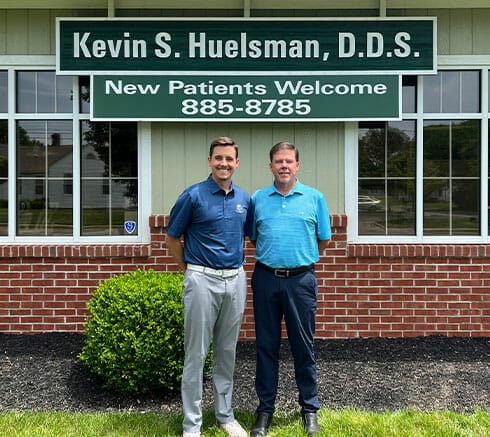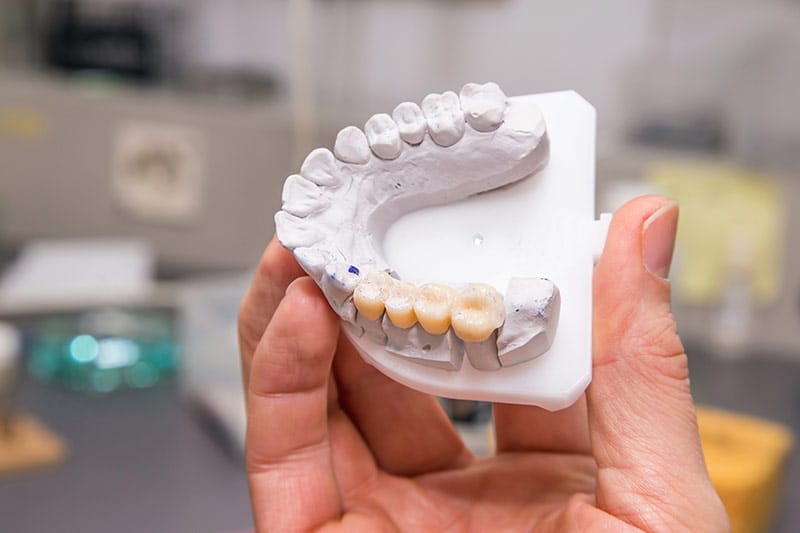Restoring your smile with dental bridges in Worthington, Ohio, is a transformative experience that blends function with aesthetics. Our doctors, Kevin and Connor Huelsman specialize in bridging the gap between healthy teeth, ensuring that each replacement fits seamlessly into your oral architecture and restores the full functionality of your bite.
Schedule a consultation for dental bridges today and begin your journey toward a full, vibrant smile.

The Advantages of Opting for Dental Bridges in Worthington, Ohio
Under Dr. Kevin Huelsman and Dr. Connor Huelsman‘s experienced care, choosing dental bridges in Worthington, Ohio, offers many benefits. Dental bridges are a tried-and-true solution for replacing missing teeth, and they play a crucial role in both the restoration of oral function and the enhancement of dental aesthetics.

Restoring Full Oral Function with Dental Bridges
Dental bridges are designed to fill the gaps left by missing teeth, restoring the ability to chew and speak properly. They correctly distribute the forces in your bite, which is essential for eating comfortably and maintaining your face’s shape. By replacing missing teeth, dental bridges also prevent remaining teeth from drifting out of position, which could lead to further oral health issues.
The Aesthetic and Functional Benefits of Dental Bridges
Beyond functionality, dental bridges provide significant aesthetic benefits. They are crafted to match the color and shape of your natural teeth, offering a seamless look that enhances your smile. A well-made dental bridge improves your appearance and boosts self-confidence and psychological well-being.

Types of Dental Bridges We Provide
Fixed Bridges
A Permanent Solution for Tooth Loss
Fixed bridges are the best solution for many patients due to their stability and durability. These bridges are non-removable and are anchored onto existing teeth or implants, offering a permanent solution to tooth loss. They are custom-made to match the natural color of your teeth and are designed to blend in seamlessly with your smile.
Removable Bridges
Versatility and Ease
For those seeking a less permanent option, removable bridges, also known as partial dentures, provide the flexibility to be taken out for cleaning or while sleeping. These bridges are an excellent option for patients, not candidates for fixed bridges or implants. They are designed for comfort and ease of use, ensuring your dental care routine does not disrupt your daily life.
Cantilever Bridges
When Adjacent Teeth Are Absent
Cantilever bridges are utilized when adjacent teeth are on only one side of the missing tooth or teeth. This type of bridge is anchored to one or more natural teeth on one side, making it a suitable option when the missing tooth does not have supporting teeth on both sides.

Determining Your Fit for Dental Bridges
Evaluating the Need for Dental Bridges
Our dental bridge services’ evaluation begins with a comprehensive oral examination. Dr. Huelsman assesses the health of your gums and the integrity of your remaining teeth, particularly those that will anchor the bridge. We also consider your oral hygiene practices, the alignment of your bite, and any other health conditions that may affect the success of a dental bridge.
The Process of Receiving Dental Bridges at Dr. Huelsman's Clinic
Once it’s determined that a dental bridge is the right choice for you, Dr. Huelsman will guide you through the process, which typically involves several steps:
The teeth that anchor the bridge are prepared by recontouring them to allow a crown to be placed over them.
Next, impressions of your teeth are made, which serve as a model from which a dental lab will make the bridge, pontic (false tooth), and crowns.
A temporary bridge will be set up to protect the exposed teeth and gums while the custom bridge is being crafted.
Once your permanent bridge is ready, the temporary bridge is removed, and the new bridge is adjusted and cemented into place.
Book Your Dental Bridge Consultation in Worthington, Ohio
Embarking on the journey to a restored smile with dental bridges in Worthington, Ohio, begins with a simple yet pivotal step: booking your consultation with Dr. Kevin Huelsman. With a commitment to personalized, respectful care, our clinic stands ready to guide you through the seamless process of obtaining your dental bridge.
Contact us today and take the first step towards a confident, complete smile.
WE LOVE OUR PATIENTS
We appreciate the opportunity to provide you with the best possible service and treat you like family and we’re proud of the reviews we receive from our patients!
CONTACT US
CONTACT US
